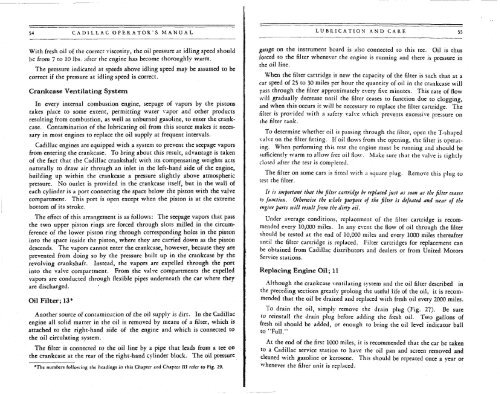1928 Cadillac - GM Heritage Center
1928 Cadillac - GM Heritage Center
1928 Cadillac - GM Heritage Center
You also want an ePaper? Increase the reach of your titles
YUMPU automatically turns print PDFs into web optimized ePapers that Google loves.
54 CADILLAC OPERATOR'S MANUAL<br />
LUBRICATION' AND CARE 55<br />
With fresh oil of the correct viscosity, the oil pressure at idling speed should<br />
be from 7 to 10 lbs. after the engine has become thoroughly warm.<br />
The pressure indicated at speeds above idling speed may be assumed to be<br />
correct if the pressure at idling speed is correct.<br />
Crankcase Ventilating System<br />
In every internal combustion engine, seepage of vapors by the pistons<br />
takes place to some extent, permitting water vapor and other products<br />
resulting from combustion, as well as unburned gasoline, to enter the crankcase.<br />
Contamination of the lubricating oil from this source makes it necessary<br />
in most engines to replace the oil supply at frequent intervals.<br />
<strong>Cadillac</strong> engines are equipped with a system to prevent the seepage vapors<br />
from entering the crankcase. To bring about this result, advantage is taken<br />
of the fact that the <strong>Cadillac</strong> crankshaft with its compensating weights acts<br />
naturally to draw air through an inlet in the left-hand side of the engine,<br />
building up within the crankcase a pressure slightly above atmospheric<br />
pressure. No outlet is provided in the crankcase itself, but in the wall of<br />
each cylinder is a port connecting the space below the piston with the valve<br />
compartment. This port is open except when the piston is at the extreme<br />
bottom of its stroke.<br />
The effect of this arrangement is as follows: The seepage vapors that pass<br />
the two upper piston rings are forced through slots milled in the circumference<br />
of the lower piston ring through corresponding holes in the piston<br />
into the space inside the piston, where they are carried down as the piston<br />
descends. The vapors cannot enter the crankcase, however, because they are<br />
prevented from doing so by the pressure built up in the crankcase by the<br />
revolving crankshaft. Instead, the vapors are expelled through the port<br />
into the valve compartment. From the valve compartments the expelled<br />
vapors are conducted through flexible pipes underneath the car where they<br />
are discharged.<br />
Oil Filter; 13*<br />
Another source of contamination of the oil supply is dirt. In the <strong>Cadillac</strong><br />
engine all solid matter in the oil is removed by means of a filter, which is<br />
attached to the right-hand side of the engine and which is connected to<br />
the oil circulating system.<br />
The filter is connected to the oil line by a pipe that leads from a tee on<br />
the crankcase at the rear of the right-hand cylinder block. The oil pressure<br />
*Thc numbers following the headings in this Chapter and Chapter HI relet to Fig. 29.<br />
gauge on the instrument board is also connected to this tee. Oil is thus<br />
forced to the filter whenever the engine is running and there is pressure in<br />
the oil line.<br />
When the filter cartridge is new the capacity of the filter is such that at a<br />
car speed of 25 to 30 miles per hour the quantity of oil in the crankcase will<br />
pass through the filter approximately every five minutes. This rate of flow<br />
will gradually decrease until the filter ceases to function due to clogging,<br />
and when this occurs it will be necessary to replace the filter cartridge. The<br />
filter is provided with a safety valve which prevents excessive pressure on<br />
the filter tank.<br />
To determine whether oil is passing through the filter, open the T-shaped<br />
valve on the filter fitting. If oil flows from the opening, the filter is operating.<br />
When performing this test the engine must be running and should be<br />
sufficiently warm to allow free oil flow. Make sure that the valve is tightly<br />
closed after the test is completed.<br />
The filter on some cars is fitted with a square plug. Remove this plug to<br />
test the filter.<br />
It is important that the filter cartridge be replaced just as soon as the filter ceases<br />
to function. Otherwise the whole purpose of the filter is defeated and wear of the<br />
engine parts will result from the dirty oil.<br />
Under average conditions, replacement of the filter cartridge is recommended<br />
every 10,000 miles. In any event the flow of oil through the filter<br />
should be tested at the end of 10,000 miles and every 1000 miles thereafter<br />
until the filter cartridge is replaced. Filter cartridges for replacement can<br />
be obtained from <strong>Cadillac</strong> distributors and dealers or from United Motors<br />
Service stations.<br />
Replacing Engine Oil; 11<br />
Although the crankcase ventilating system and the oil filter described in<br />
the preceding sections greatly prolong the useful life of the oil, it is recommended<br />
that the oil be drained and replaced with fresh oil every 2000 miles.<br />
To drain the oil, simply remove the drain plug (Fig. 27). Be sure<br />
to reinstall the drain plug before adding the fresh oil. Two gallons of<br />
fresh oil should be added, or enough to bring the oil level indicator ball<br />
to "Full."<br />
At the end of the first 1000 miles, it is recommended that the car be taken<br />
to a <strong>Cadillac</strong> service station to have the oil pan and screen removed and<br />
cleaned with gasoline or kerosene. This should be repeated once a year or<br />
whenever the filter unit is replaced.
















